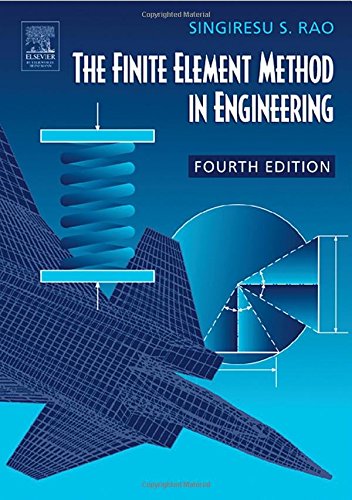
Synopsis
The Finite Element Method in Engineering is the only book to provide a broad overview of the underlying principles of finite element analysis and where it fits into the larger context of other mathematically based engineering analytical tools. This is an updated and improved version of a finite element text long noted for its practical applications approach, its readability, and ease of use. Students will find in this textbook a thorough grounding of the mathematical principles underlying the popular, analytical methods for setting up a finite element solution based on mathematical equations.
The book provides a host of real-world applications of finite element analysis, from structural design to problems in fluid mechanics and thermodynamics. It has added new sections on the assemblage of element equations, as well as an important new comparison between finite element analysis and other analytical methods showing advantages and disadvantages of each.
This book will appeal to students in mechanical, structural, electrical, environmental and biomedical engineering.
- The only book to provide a broadoverview of the underlying principles of finite element analysis and where it fits into the larger context of other mathematically based engineering analytical tools.
- New sections added on the assemblage of element equations, and an important new comparison between finite element analysis and other analytical methods, showing the advantages and disadvantages of each.
"synopsis" may belong to another edition of this title.
About the Author
Mechanical Design, Optimization and Reliability in Mechanical and Structural Design, Finite Element methods, Structural Dynamics.
RESEARCH/SPECIALIZATION:
1. Multi-objective optimization.
2. Uncertainty models in engineering analysis, design and optimization.
3. Reliability based design.
4. Finite element and meshfree methods.
5. Optimization and reliability of renewable energy systems.
BOOKS PUBLISHED:
The Finite Element Method for Engineers, 5e, Elsevier, 2010; Mechanical Vibrations, 6th Edition, Pearson, 2016; Engineering Optimization Theory and Practice, 4th Edition, Wiley, 2009; Reliability Engineering, 1st Edition, Pearson, 2014
From the Back Cover
Finite Element Analysis is an analytical engineering tool developed in the 1960's by the Aerospace and nuclear power industries to find usable, approximate solutions to problems with many complex variables. It is an extension of derivative and integral calculus, and uses very large matrix arrays and mesh diagrams to calculate stress points, movement of loads and forces, and other basic physical behaviors. Students will find in this textbook a thorough grounding of the mathematical principles underlying the popular, analytical methods for setting up a finite element solution based on those mathematical equations. It quickly bridges that knowledge to a host of real-world applications--from structural design, to problems in fluid mechanics and thermodynamics. Professional engineers will benefit from the introduction to the many useful applications of finite element analysis, and will gain a better understanding of its limitations and special uses. New to this edition:· New sections added on the assemblage of element equations, and an important new comparison between finite element analysis and other analytical methods…showing advantages and disadvantages of each· Improved sample and end-of-chapter problems
"About this title" may belong to another edition of this title.
Search results for The Finite Element Method in Engineering
The Finite Element Method in Engineering (Fourth Edition)
Seller: Florida Mountain Book Co., Datil, NM, U.S.A.
Condition: Good+. Hardcover, [xix], 663 pages. Good+ condition. Fourth edition. Size 10.5"x7.5". This book provides "a broad overview of the underlying principles of finite element analysis and where it fits into the larger context of other mathematically based engineering analytical tools . . . . This book will appeal to students in mechanical, structural, electrical, environmental and biomedical engineering." Book has moderate handling/shelfwear. Previous owner's name on text block top edge, text else Near Fine, clean and unmarked. Seller Inventory # 009948
The Finite Element Method in Engineering
Seller: Anybook.com, Lincoln, United Kingdom
Condition: Good. This is an ex-library book and may have the usual library/used-book markings inside.This book has hardback covers. Clean from markings. In good all round condition. Please note the Image in this listing is a stock photo and may not match the covers of the actual item,1500grams, ISBN:9780750678285. Seller Inventory # 8965096
Buy Used
Quantity: 1 available
The Finite Element Method in Engineering
Seller: Anybook.com, Lincoln, United Kingdom
Condition: Fair. This is an ex-library book and may have the usual library/used-book markings inside.This book has hardback covers. In fair condition, suitable as a study copy. Please note the Image in this listing is a stock photo and may not match the covers of the actual item,1500grams, ISBN:9780750678285. Seller Inventory # 5561963
Buy Used
Quantity: 1 available
The Finite Element Method in Engineering
Seller: Anybook.com, Lincoln, United Kingdom
Condition: Good. This is an ex-library book and may have the usual library/used-book markings inside.This book has hardback covers. In good all round condition. Please note the Image in this listing is a stock photo and may not match the covers of the actual item,1500grams, ISBN:9780750678285. Seller Inventory # 5561962
Buy Used
Quantity: 1 available
The Finite Element Method in Engineering
Seller: Phatpocket Limited, Waltham Abbey, HERTS, United Kingdom
Condition: Good. Your purchase helps support Sri Lankan Children's Charity 'The Rainbow Centre'. Ex-library, so some stamps and wear, but in good overall condition. Our donations to The Rainbow Centre have helped provide an education and a safe haven to hundreds of children who live in appalling conditions. Seller Inventory # Z1-Q-001-03015
Buy Used
Quantity: 1 available
